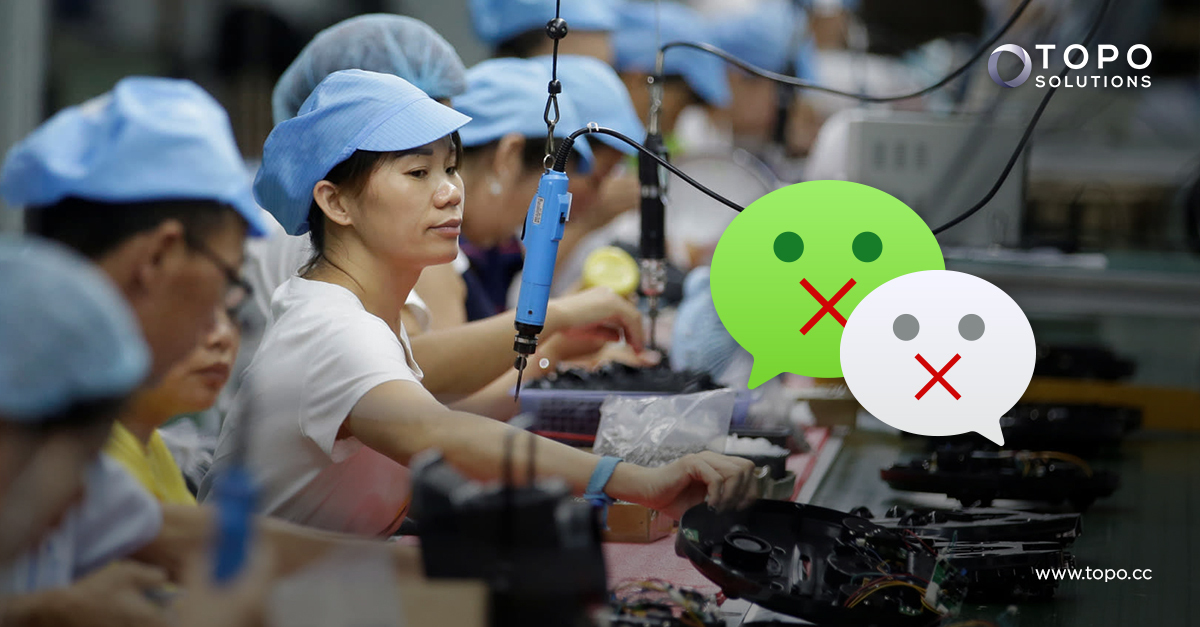Request a Demo
Trusted by leading brands, retailers, manufacturers and service providers across industries such as:
















This makes WeChat a default choice for collaboration and communications within the supply chain. Threats to ban the service in the U.S. are causing significant concern[2] to companies that rely on instant, ubiquitous communication between the U.S. and China, so much so that some are even raising lawsuits[3].
This is certainly a valid concern but we believe it points to another, bigger issue: A significant lack of fast, responsive, reliable, ubiquitous supply chain communication tools[4]. Part of the dependency on WeChat and similar platforms is that there are not that many great alternatives.
We think it’s worth exploring:
WeChat and its importance to business
WeChat is the fifth most popular social media app in the world[5], and the most popular social app in China. The service passed a billion users in early 2019 and is now approaching 1.2 billion users. In China, WeChat is used by 90 percent of the Chinese population and accounts for over a third of the country’s internet traffic[6].
Many of WeChat’s users are individuals, but businesses have also become incredibly reliant on WeChat and its WePay platform. WeChat Work is used by more than 2.5 million companies and has over 60 million monthly users[7]. Over 32 percent of users are corporate businesses, with another 28 percent being self-employed, freelance, or remote workers[8].
There are several business advantages to using WeChat[9]:
32 percent of users reported selling products through WeChat
40 percent of users carry out customer service through the app
34 percent cut costs by using WeChat
Many Chinese businesses rely almost exclusively on WeChat to run their operations[10].
In August 2020, the president signed an executive order[11] with an intent to block the use of WeChat and the video-messaging app, TikTok, in the U.S.
“WeChat automatically captures vast swaths of information from its users. This data collection threatens to allow the Chinese Communist Party access to Americans’ personal and proprietary information. In addition, the application captures the personal and proprietary information of Chinese nationals visiting the United States, thereby allowing the Chinese Communist Party a mechanism for keeping tabs on Chinese citizens who may be enjoying the benefits of a free society for the first time in their lives.”
— Executive Order on Addressing the Threat Posed by WeChat, The White House[12]
As of August 2020.
“People familiar with the matter said the Trump administration is privately seeking to reassure U.S. companies including Apple Inc. that they can still do business with Tencent’s WeChat messaging app in China. In recent days, senior administration officials have been reaching out to some companies, realizing that the impact of an all-out ban on the popular app could be devastating for U.S. technology, retail, gaming, telecommunications, and other industries.”
— Bloomberg, Tencent gains after administration assurances[13]
Regardless of the political intent and drivers behind this ban, it creates many real-world economic and practical problems for sourcing, manufacturing, collaborating on, and distributing goods through the global supply chain ecosystem.
“Manufacturers rely on WeChat for direct communication between the U.S.-based engineers who design new gadgets and the Asia-based manufacturing teams who figure out how to build them. A ban of this service would provide yet another obstacle for engineering teams working on new gadgets… …This year, Covid-19 made travel impossible, so these teams went digital. Emails, video calls, and WeChat filled the gap (Google and Zoom are blocked in China). U.S.-based engineering teams shifted their work schedules to correspond with when the lines are running in China – sitting on WeChat or FaceTime phone calls for many hours at a time.” — Forbes, WeChat Ban May Cut A Vital Lifeline To Chinese Factories For U.S. Electronics Brands[14].
Of course, the problems with a WeChat ban are much deeper and more widespread than just slowing down innovation. All sorts of supply chain companies rely on WeChat communication and collaboration:
This has all been exacerbated by COVID-19—product category managers, salespeople, and other stakeholders cannot travel to see suppliers or manufacturers. Product developers cannot go to trade fairs to understand what’s coming down the pipe. This all adds to the complexity of remote work, making instant, friction-free supply chain collaboration and communication even more vital.
There are numerous examples of how this can impact U.S.- and China-based companies:
“WeChat, which has more than 1 billion users and is owned by Tencent Holdings Ltd., is relied upon so heavily that many people have never exchanged phone numbers or emails. From Wal-Mart Inc. and Starbucks Corp. to the NBA and Nike Inc., nearly every major American consumer brand with business in China is deeply intertwined with Tencent and its network, which includes WeChat and investee JD.com” — Yahoo Finance, Trump’s WeChat Ban Brings Cold War With China Into a Billion Homes[15]
While we wait for the WeChat U.S. ban to play out, it’s worth looking at the other supply chain issues exposed by these actions and how we can improve on them.
WeChat is only the tip of the supply chain communications iceberg. It’s certainly true that its dominance in China, combined with the breadth and usefulness of its offerings makes it the default choice for communications—but that doesn’t mean it’s the best choice.
For all of their functionality, speed, and usage, general communication tools may not be the best fit for industry-specific needs. This extends beyond WeChat—other common tools like email, video conferencing, or instant messaging are not the right choice for specific use cases.
This is especially important for supply chain management, logistics, distribution, sourcing, and manufacturing. Let’s dig into it.
Supply chain management is extremely specialized. Every organization involved in the supply chain needs to manage its information and communications in a unique way—ensuring that communications and data management are not just limited to the business itself, but that they are easily extensible to supply chain partners.
This means introducing standards and frameworks that every supply chain organization can work to—common means of transferring information, integration with existing systems, and automation to reduce manual errors and rekeying. It can be difficult to set up standard communication apps to have a unified approach, resulting in a complex mix of processes and technologies that create inefficiency.
The complexity of dealing with so much supply chain information is exacerbated if you’re having to manage multiple inputs and types of data. Centralization is very important for supply chain management, allowing stakeholders to understand their own part in the network and also the network as a whole.
This means having “one-source-of-the-truth” as a centralized resource that is continually updated in real-time is essential. Standard communications apps do not have this functionality, but the right supply chain management platform can integrate across multiple data sources and communications channels.
Finally, communications, information, and data sharing can be very specialized for supply chain organizations. That’s not just in regards to placing and processing orders or arranging customs paperwork. It extends into areas such as live quality monitoring, lab testing, regulations and compliance, factory audits, product ideation and development, quotations and negotiating, sampling, sustainability, and more.
Having to use general communication tools to share information about this work is at best cumbersome, and at worse risks you breaching regulatory standards. Instead, platforms and communication tools designed around this type of supply chain collaboration unlocks the power of end-to-end visibility.
The takeaway here is that relying on general communication tools like WeChat or even email or MS Teams, isn’t ideal for supply chain organizations. In fact, for U.S. companies that depend on WeChat to deal with Chinese suppliers, the future is very uncertain.
Instead, merchants, suppliers, manufacturers, and others need to see out specialized supply chain communication platforms that give them the efficiency, scalability, and flexibility they need.
Topo is a whole new breed of supply chain management software. It is a powerful collaboration, automation, and analytics platform connecting all sourcing, quality, compliance, and sustainability stakeholders. You can collaborate with all members of your in-house team, manufacturers, and service providers throughout your supply chain.
[1] https://www.brookings.edu/research/global-manufacturing-scorecard-how-the-us-compares-to-18-other-nations
[2] https://www.wsj.com/articles/corporate-america-worries-wechat-ban-could-be-bad-for-business-11597311003
[3] https://www.wsj.com/articles/lawsuit-claims-u-s-wechat-ban-is-unconstitutional-11598059765
[4] https://www.oxfordcollegeofprocurementandsupply.com/why-communication-is-key-to-supply-chain-success/
[5] https://www.businessofapps.com/data/wechat-statistics/
[6] https://www.businessofapps.com/data/wechat-statistics/
[7] https://www.chinainternetwatch.com/30201/wechat-stats-2019/
[8] https://technode.com/2015/02/10/wechat-impact-report/
[9] https://walkthechat.com/wechat-impact-report-2016/
[10] https://www.theverge.com/2020/8/7/21358252/tencent-wechat-ban-trump-executive-order-consequences
[11] https://www.crowell.com/NewsEvents/AlertsNewsletters/all/New-Executive-Orders-Start-Clock-Ticking-for-TikTok-and-WeChat
[12] https://www.whitehouse.gov/presidential-actions/executive-order-addressing-threat-posed-wechat/
[13]https://www.bloomberg.com/news/articles/2020-08-24/tencent-gains-26-billion-after-u-s-reassurances-on-wechat-ban
[14] https://www.forbes.com/sites/annashedletsky/2020/08/07/wechat-ban-may-cut-a-vital-lifeline-to-chinese-factories-for-us-electronics-brands/#2e473a104250
[15] https://finance.yahoo.com/news/trump-wechat-ban-brings-cold-133000467.html